More Meaningful Feedback: How Online Engagement Software Makes A Difference

Great community engagement relies on getting meaningful feedback from residents on a given project. Meaningful feedback makes engagement efforts worthwhile, provides valuable insights to project teams, and builds public trust by improving the relationship between residents and local government.
To ensure you’re on track to achieve meaningful engagement, ask these three questions:
- Is there a strategy to reach residents who most need to hear from us?
- Are residents getting enough information to make an informed decision?
- Do we have a plan to distill or make sense the input we receive?
Meaningful feedback rarely comes from a one-off online survey tool or posting on social media and crossing your fingers. The problem is, it can feel like there are no better options – even if that means constantly starting over on every project, using the same antiquated approaches for each outreach effort.
The right online engagement strategy should be able to:
- Reach a representative and/or desired population
- Educate the public on the issues at hand
- Quickly analyze comments to find patterns and understand public sentiment
- Lower barriers to participation through flexible online engagement formats
This is where the right strategy is supported by the right online engagement software. Keep reading for real-life examples of how community engagement software is making a difference in cities across America or see it live right now.


City of San Diego Parks & Recreation Master Plan
AECOM, the world’s largest engineering and design firm is currently working with The City of San Diego on a master plan for the city’s parks and recreation facilities. From the onset, the project team recognized the importance of reaching the south side of the city: home to a typically underrepresented community of low-income, Spanish speaking residents.
When it comes to community engagement, it is not uncommon to struggle with the initial challenge of getting the word out and creating project awareness – especially for hard to reach groups. However, AECOM’s work in San Diego has used a strategy of combining offline and online efforts by way of online engagement software. Their method included both geo-targeted Facebook advertising and pop-up events at community centers – with a central online hub to bring together all interactions.
Facebook targeting:
Through social media targeting, AECOM was able to put emphasis on reaching residents in southern San Diego. In addition, both the Facebook posts and the project website itself were translated into Spanish. Recognizing the importance of lowering barriers to entry, the online engagement was setup to allow anonymous participation, and ask for contact information and demographics separately. Through this strategy, the project saw increase input from typically underrepresented voices, yielding more representative input: an equal distribution of where and who feedback was coming from.
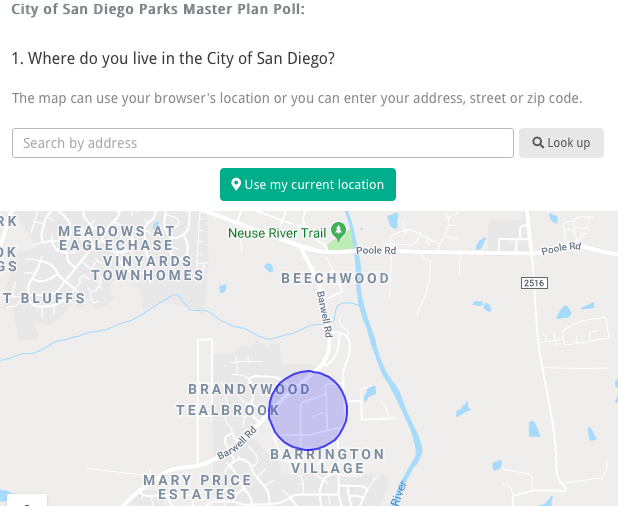
Dynamic location question – AECOM was able to understand where participation was coming from and re-target “gap” areas.
In-Person Events:
Community engagement largely hinges on meeting people where they are – oftentimes literally. After initial project outreach, AECOM was able to identify gap areas and target them not just online, but also offline with pop-up style events at community centers in those same areas. At these informational sessions, The City of San Diego educated residents on the master plan and directed them to a website where they could provide feedback.
These in-person events:
- Reached a typically underrepresented group
- Educated residents on the issues at hand – creating more informed feedback
- Captured contact information and asked questions that mirrored the online engagement activities
With two more years to go on the project, AECOM’s work in San Diego has already engaged 1,800 participants who provided 58,000 responses to questions and contributed 6,000 comments.
6,000 comments sounds like a lot of work, right?
Not if you have engagement tools that help make sense of it.
Comment Analysis:
Traditional qualitative analysis of comments can be painstaking. Oftentimes only the most extreme comments stick with us, which can be discouraging or steer a project in the wrong direction despite our best intentions.
The ultimate question is: How do you turn qualitative comments into meaningful data?
If we can’t make sense of the comments we receive, then they really can’t be meaningful feedback.
Here’s how AECOM used online engagement software to understand comments:
- AI-powered smart tagging to group and analyze key themes and entities
- Tagging rules to automatically group and tag similar comments
- Sentiment analysis to understand which words and phrases were mentioned negatively, positively, or neutrally
- Visual analysis using smart word clouds and tag clouds
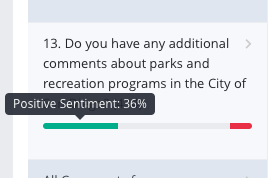
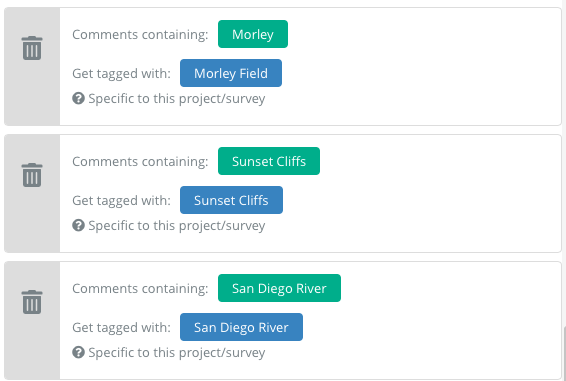

Not only does this approach leverage technology to save a lot of time, it also makes feedback more meaningful.
Educating the public with engagement hubs and project websites
Online engagement software provides the unique opportunity to build project websites and entire engagement hubs where text, photos, documents, and meeting calendars can be uploaded to better educate the public before providing input. By increasing public knowledge, feedback becomes more meaningful.
The North Carolina Department of Transportation is an example of one such community engagement hub. On the NCDOT engagement hub residents can:
- View all current projects and participate
- See upcoming meetings and RSVP
- Sign up for email or text updates
- See the latest social posts from NCDOT
Each published project has its own project website with introductory text and dynamic questions. These questions go beyond typical surveys to include photos and downloadable PDFs for more in-depth information and understanding. For example, graphics like this are provided alongside questions to visually display alternatives between proposed infrastructure changes:
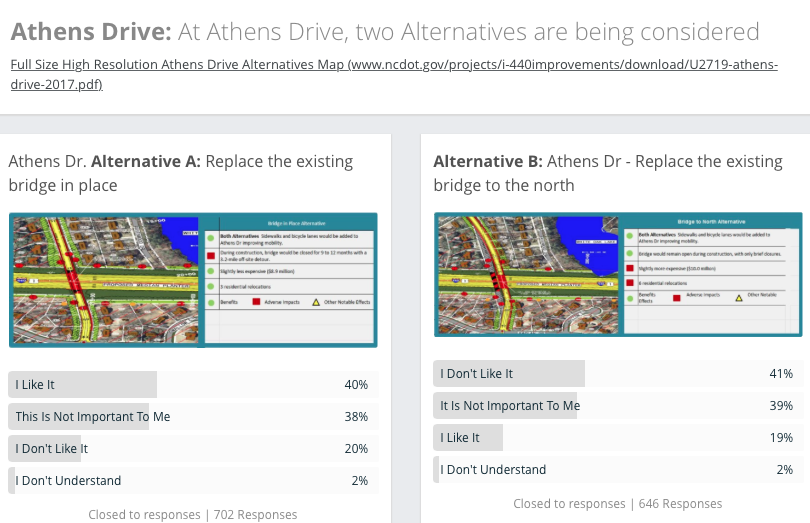
With dynamic questions, content, and comment sections, the project website is much more informative and engaging than just a stand-alone survey. As the public becomes more informed, it increases their confidence in their ability to contribute, and also that their feedback will be actionable.
Likewise, residents are also encouraged to provide contact information on project websites so that the NCDOT can follow up to close the loop.
Creating a project website is simple, using drag and drop creation:
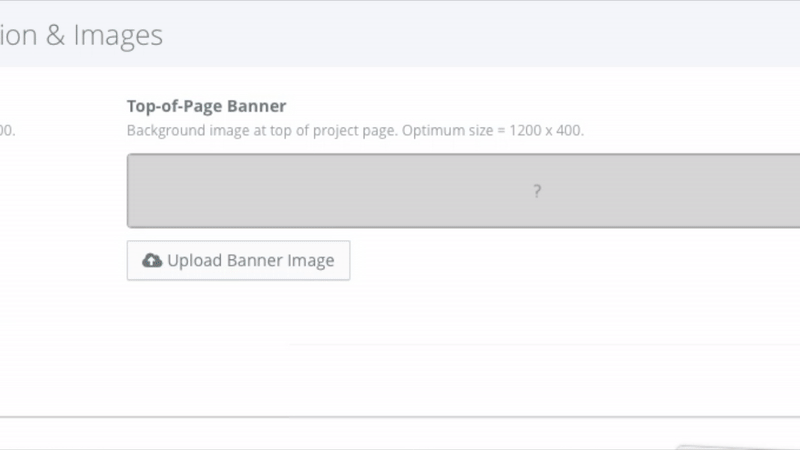
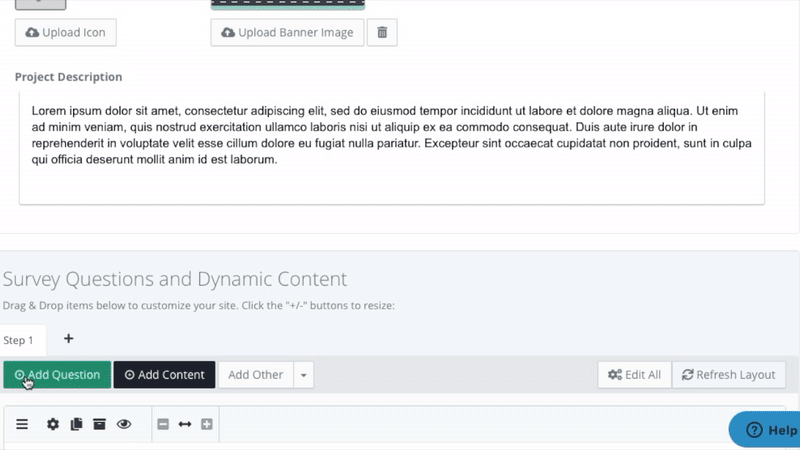
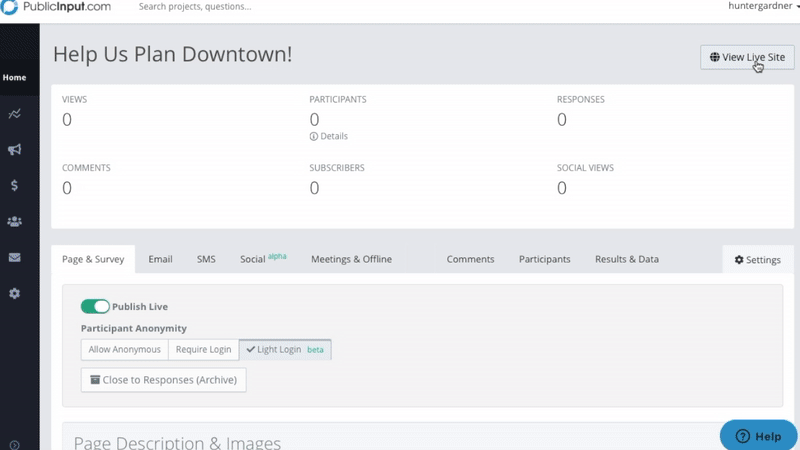
Add a banner image and project description
Add dynamic questions
Your project website is all done!






